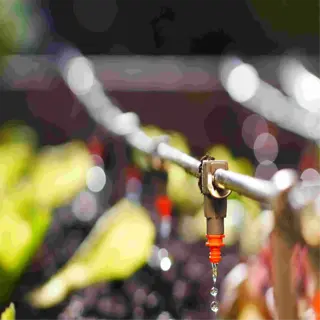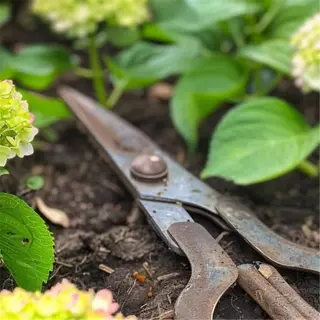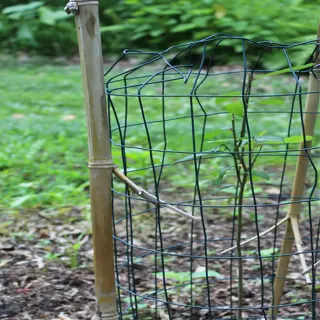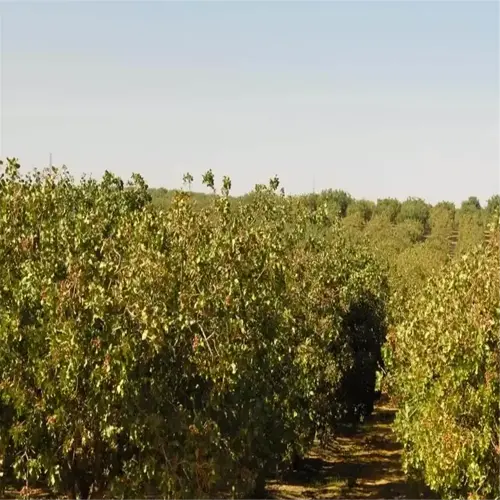How to Grow Pomegranate: Expert Tips for Success

Written by
Julia Anderson
Reviewed by
Prof. Charles Hartman, Ph.D.how to cultivate pomegranate: Ensure proper drainage and sunny location
Consider cold-hardy varieties like'Salavatski' that can grow in zones 6-10
Annually prune for airflow and more fruit; avoid cutting too much of the old wood off
Use neighbor trees or companion planting (such as marigolds) for pest management in addition to neem oil sprays
You know they are ready to pick when the fruits sound like metal when tapped on, and the color becomes dark from saturation
For faster production you can propagate hardwood cuttings instead of growing them from seed
Article Navigation
The first consideration for understanding how to grow pomegranate trees is their climactic tolerance. Pomegranates survive in USDA landscape zones 7-11, tolerating brief frosts down to 12°F. Pomegranates prefer sunny locations with soil that drains well. While some varieties are drought-resistant, these plants require a weekly dose of water during the fruit growth period.
Pomegranates provide a twofold payoff: lush and vibrant orange-red blooms, as well as fruit with a strong antioxidant nutritional benefit. I've noticed that some atypical gardeners prefer how the pomegranate tree looks while still harvesting 20-30 fruits each year. In early spring, add a balanced fertilizer. It is important that the soil does not remain too wet. Root rot is a silent killer that affects many plants in poorly drained soil beds and pots.
New growers commonly inquire about the timelines for various cultivars. Most trees will begin to fruit in three to five years. I had my first harvest in the fourth year. Patience pays. Initially. You should focus on root health. You will have those glossy flowers. Then you will have the fruit you have been nurturing, gleaming like jewels.
Planting and Care Essentials
Bare-root pomegranate trees require some attention to roots before planting.Soak roots the night before planting to allow them to hydrate.Dig a hole wide enough to allow for spreading the limbs and roots to avoid crowding.I have found that bare-root plants have the best establishment when the roots and limbs have established contact with the soil.Trees in pots are easier to plant, but check the roots, they may be circling the pot.Trim them significantly.
What are the challenges of clay soil? Build raised beds 8-10 inches tall. Remember to add some coarse sand and compost.A good proportion. This is how we manage waterlogging in my orchard in Georgia. If you have gophers, they may be a concern in the raised bed. Place landscape fabric along bed bottoms if you find gophers. You can improve yield by 30% in heavy soils with proper drainage. Here - watch your zinc levels - zinc deficiencies hit us frequently.
Every year after fruiting, prune all of the Wonderful types. Prune out any branches that are growing inward. Salavatski needs your pruning every other year for best results, pruning them in a norm will unnecessarily stress the tree. Last spring if over-pruned a young tree and it skipped fruiting. Allow vertical leaders to grow 12- 18 inches a year. Disinfect your shears with rubbing alcohol between plants.
Yellow-green veined leaves? That is a classic sign of zinc deficiency. Apply a foliar spray (1/2 strength) when the plant is actively growing. If applying other amendments, add that with the foliar zinc as well. I also incorporate composted manure for a long-lasting fix to the soil. A note: do a pH test before adding anything. Soils that are high in alkalinity can lock zinc out. Sulphur amendments can help lower the soil's pH while providing sulphur.

Drip Irrigation
- Fact: Reduces fungal disease risk by keeping foliage dry while delivering 1-2 gallons (3.8-7.6 liters) hourly
- Use pressure-compensating emitters for sloped terrain to ensure even water distribution
- Install 12-18 inches (30-46cm) from trunk to encourage outward root growth

Pruning Shears
- Fact: Bypass-type blades required for clean cuts on wood up to 0.75 inch (1.9cm) diameter
- Sterilize with 70% isopropyl alcohol between trees to prevent disease transmission
- Sharpening frequency: Every 10 pruning sessions maintains optimal cutting performance

Soil pH Tester
- Fact: Digital meters provide instant 5.5-7.2 pH range verification
- Calibrate monthly using buffer solution for accuracy
- Test at 6-8 inch (15-20cm) depth around drip line

Rooting Hormone
- Fact: 0.3% IBA powder increases hardwood cutting success rate by 40%
- Dip cuttings for 3 seconds before planting in perlite-vermiculite mix
- Store at 40-70°F (4-21°C) to maintain potency

Tree Guards
- Fact: Plastic spiral guards prevent rodent damage up to 18 inches (46cm) height
- Install 2 inches (5cm) below soil line to block burrowers
- Replace every 3 years to prevent trunk constriction
Choosing the Right Variety
Choosing a variety of pomegranates begins with a consideration of climate requirements. The standard cultivar is *‘Wonderful'* because most of the commercial pomegranates are *‘Wonderful'* which produce over 80 to 100 fruits per tree; however, grows poorly if frost is below Zone 7. If you live in a colder region *‘Salavatski'* can handle the winters of Zone 6 if mulched. I have seen it regrow from -10°F. Choose a cultivar that aligns with your frost patterns.
Urban farmers should consider dwarf ‘Ambrosia'.At only 5 feet tall, it's the right fit for patio pots, but will still produce 15-20 fruits in a season! The 20-gallon container on my balcony is thriving. I mix perlite into the potting soil to ensure good drainage.These compact types bear fruit a little earlier too - usually during their third year!
There are many myths about pollination. Even though most pomegranate varieties are self-pollinating, when you pair them together, they will produce 20% more fruit. For this reason, I interplant 'Eversweet' and 'Parfianka' to promote cross-pollination. Plus, this encourages bees to move pollen from one pale flower to the other purple flower. But a single tree will still produce fruit - my first harvest was one single 'Salavatski' tree.
Flavor determines variety selection. The tart ‘Wonderful' is king in juicing - its crimson arils hold 40% more antioxidants than other commercially acceptable varieties. The sweet ‘Eversweet' has none of the tannins associated with fresh eating quality. You should sample fruit before you begin planting to select the type you prefer at your local fruit nurseries. I regret planting six sour cultivars before knowing dessert varieties existed.
Climate Considerations
- Heat tolerance: Varieties like 'Wonderful' require 120+ days >85°F (29°C)
- Cold survival: 'Salavatski' withstands -10°F (-23°C) with trunk protection
- Humidity resistance: 'Kazake' resists fungal issues in high rainfall areas
Space Optimization
- Dwarf options: 'Nana' (3ft/0.9m) suits patio pots
- Pruning limits: Standard varieties need 12-15ft (3.6-4.5m) spacing
- Multi-trunk vs single: Bushes maximize small spaces; trees ease harvesting
Harvest Goals
- Juice yield: 'Girkanets' produces 40% more juice than average
- Storage needs: Thick-rinded 'Al-sirin-nar' lasts 6+ months refrigerated
- Seed hardness: 'Sweet' cultivars have 80% softer seeds
Pest/Disease Resistance
- Leaf-footed bugs: 'Ambrosia' shows 30% less damage than other dwarfs
- Fungal rot: 'Salavatski' tolerates wetter soils up to 25 inches (63.5cm) annual rainfall
- Aphid susceptibility: 'Parfianka' requires 50% fewer treatments than standard varieties
Soil Compatibility
- pH range: 'Wonderful' thrives in 5.5-7.0 pH vs. 'Kazake' (6.0-7.5)
- Clay tolerance: 'Eversweet' survives waterlogged soils up to 3 days
- Sandy soil fixes: Add 2-3 inches (5-7.6cm) compost annually for dwarf varieties
Climate and Soil Requirements
‘Salavatski' pomegranates go against stereotypes for the climate they can thrive in, surviving Zone 6 winters as long as the trunk is wrapped and mulch is piled on heavily. I have protected young trees of that variety through stretches of -5°F (-21°C) weather outside using burlap sleeves around the tree. Compare this to ‘Wonderful', which seems to require Zones 7 and above in their winter stability. This reliably frost-tender wood needs protection if temperatures dip below 15°F (-9°C).
Soil acidity: it is crucial for the success of pomegranate. Test kits show the optimum range would be 5.5-7.2. My orchard in Arizona struggled for almost five years until I amended the alkaline soil with sulfur. Containerized plants have a buffer of +or- 0.5 so I use acidifying fertilizers once a month. Did you water just prior to this? Have poor drainage? dig a 12 inch (30cm) hole and fill with water, if it is slower than 1 inch (2.5cm) hour, put gravel in.
A mature tree can tolerate winter temperatures down to 7°F (-14°C) provided that its roots are not saturated with moisture.I lost three saplings before I realized that moisture in winter kills more trees than cold.In rainy climates, plant trees in elevated planting sites. I always recommend a 30% coarse sand mix into heavy clay soils. Root rot will emit a sour odor; be sure to react promptly when this is detected.
Container growers encounter special circumstances. Use potting mixes containing perlite for proper drainage and aeration. I have saved waterlogged plants, primarily pomegranates, by adding orchid bark. Examine the saucers daily; if left stagnant, they harbor damaging Phytophthora fungi. Pomegranates do significantly better in drought than in soggy conditions.
pH Adjustment
- Acidic soils: Apply 5-10lb (2.3-4.5kg) dolomite lime per 100sqft (9.3m²) to raise pH 0.5
- Alkaline soils: Mix 2-4lb (0.9-1.8kg) elemental sulfur per 100sqft to lower pH 0.5
- Container plants: Use peat-free mixes with 20% pine bark fines for acidity
Drainage Enhancement
- Clay soils: Till in 3" (7.6cm) gravel sand to 18" (46cm) depth
- Raised beds: Build 12-18" (30-46cm) height with 40% coarse sand blend
- Slope grading: Create 2% slope away from trunks to prevent water pooling
Frost Protection
- Trunk wrapping: Use breathable tree wrap below 25°F (-4°C)
- Root zone mulch: 6" (15cm) straw layer extends root hardiness to 10°F (-12°C)
- Overhead irrigation: Run during freeze events to maintain 32°F (0°C) via latent heat
Heat Management
- Sunscald prevention: Paint trunks white with latex mix for 110°F (43°C)+ climates
- Canopy shading: Use 30% shade cloth during fruit set in arid zones
- Mulch depth: 4" (10cm) organic mulch reduces soil temps by 10-15°F (5-8°C)
Organic Matter Management
- Clay soils: Add 2-3 inches (5-7.6cm) compost annually to improve texture
- Sandy soils: Mix 10-15% coconut coir to retain moisture and nutrients
- Compost tea: Apply monthly during growing season for microbial activity boost
Pest and Disease Solutions
Neem oil provides organic pest management with a 3-day protective film. I use it in the evening after the bees have settled for the night. There are chemical choices available, like imidacloprid, which works systemically but has a devastating systemic effect on pollinators, and I lost a hive last year after imidacloprid was chemically applied to some nearby trees. Since then, I've shifted more to plant-derived materials.
Every spring, aphids saturate new growth. Either crush newly infested plants by hand, or blast them off with your hose. Leaf-footed bugs appear in the late summer - their bronze shield shape blends well with ripe fruit. Disrupt their life cycle by trapping them with sticky bands around the trunks. When it's warmest I check traps, with sticky bands, usually at least every three days.
Worried about fungi? You probably overwatered. My orchard's powdery mildew improved by 70% when I began drip irrigation and watering at the base of the tree before dawn. Space plants 8-10 feet apart when planting - the canopy collects humidity and provides an environment for fungi. Prune any infected branches immediately and burn them.
Marigolds are not simply decorative plants. If you want to mitigate root-knot nematodes, plant French marigolds 12 inches from the pomegranate. I plant garlic in the same area as well; its sulfur compounds repel the borer. Using companion planting techniques has both increased my harvest yield more than two-fold and reduced my pesticide utilization. Rotate the location of marigolds each subsequent growing season for improved results.
Cultural Controls
- Pruning: Open canopy to 45° angle for airflow
- Watering: Avoid wetting foliage; use drip irrigation at 1-2 gallons (3.8-7.6L)/hour
- Sanitation: Remove fallen fruit within 48 hours
Organic Sprays
- Neem oil: Disrupts pest life cycles for 7-10 days
- Horticultural soap: Kills soft-bodied insects at 2.5oz (74ml)/gallon
- Bacillus thuringiensis: Targets caterpillars without harming bees
Monitoring
- Sticky traps: Place yellow cards 3ft (0.9m) high for whiteflies
- Degree-day models: Treat aphids at 450-500°F (232-260°C) growing degree units
- Soil tests: Check nematode levels before planting
Companion Plants
- Marigolds: Repel root-knot nematodes when planted 6" (15cm) from trunks
- Garlic: Deters borers; plant 8-12" (20-30cm) apart
- Basil: Masks tree scent from fruit moths
Resistant Varieties
- 'Eversweet': 40% less aphid attraction
- 'Salavatski': Tolerates bacterial blight at 75°F (24°C)+
- 'Parfianka': Thick rind reduces fungal penetration by 60%
Harvesting and Storage Tips
A ripe pomegranate sings when tapped, and you want to listen for a metallic ping. The color darkens from pink to ruby red as sugars concentrate in the fruit during harvest season. I test ten fruits a day during the harvest. The pomegranates that have a slight crack at the crown usually turn out to be the sweetest. A bruised fruit doesn't have the same flavor, so handle them gently.
Keep your harvest in the range of 32-40°F (0-4°C) with humidity maintained at 65-70 percent. I use the crisper drawers in my refrigerator, lined with parchment paper. Do not cover with plastic wrap, because it holds in moisture, eventually causing mold. I once had my arils perfectly preserved for six months, and I stored them into breathable produce bags.
I cut stems flush with my pruning shears, avoiding stubs that would push into neighboring fruits. I generally cut at an angle downwards to shed rainwater. One very disappointed client lost 50 pounds of fruit to stem rot from ragged cuts. I also make sure to clean the blades of my pruners while working between trees to avoid spreading any potential diseases.
Freeze entire fruits for future cooking as they remain fresh for up to 10 months. For arils that can be eaten directly, make sure you lay them out on baking sheets to freeze first. I have found this way to keeps my frozen arils from freezing in clumps. If you thaw them, they will still work as a smoothie ingredient, but will not have the crunch desired in salads.
Cold Storage
- Temperature: Maintain 32-40°F (0-4°C) with ±5°F fluctuation tolerance
- Packaging: Use perforated plastic bags to maintain 65-70% humidity
- Ethylene: Keep separate from apples/bananas to prevent over-ripening
Freezing Techniques
- Whole fruit: Wrap in parchment paper; thaws in 1-2 hours at room temp
- Arils: Spread on baking sheet pre-freeze to prevent clumping
- Juice: Pour into ice cube trays for portion control
Juicing & Processing
- Press method: 2-3 medium fruits yield 1 cup (240ml) juice
- Pasteurization: Heat to 165°F (74°C) for 30 seconds to kill pathogens
- Bottling: Leave 0.5" (1.3cm) headspace for expansion
Drying Methods
- Dehydrator: 135°F (57°C) for 8-12 hours until leathery
- Sun-drying: Cover with cheesecloth; rotate every 2 hours
- Storage: Keep in airtight jars with silica gel packets
Common Mistakes
- Wet fruit storage: Increases bacterial growth by 300%
- Plastic wrap contact: Causes condensation-induced mold
- Refrigerator crisper: Excess humidity accelerates rind breakdown
5 Common Myths
Pomegranates need daily pruning to bear fruit!
Pomegranates bear on 2-3 year old wood. Pruning too much reduces yield. Light pruning for shaping each year after harvest is adequate. You should only remove dead and/or damaged branches and suckers to keep airflow. Heavy cutting will remove fruiting spurs.
They only thrive in desert-like climates
Pomegranates are drought tolerant but want to grow in USDA zones 7-10 with 120+ frost-free days. 'Salavatski' is cold-hardy; it can withstand -10°F (-23C) when used with mulch. Pomegranates accept humidity well but need well-draining soil.
You need two trees in order to pollinate;
95% of cultivars are self-fertile. A single tree will produce between 50-100 fruits annually. Cross-pollination will increase yields by 15-20% (but is not required). Bees/hummingbirds will be transferring pollen among the flowers of your tree.
Container growing halts fruiting
Dwarf varieties like 'Nana' produce 10-15 fruits in 15-gallon (57-liter) pots. Use loamy mixture and root-prune every 3 years. Container trees often produce earlier than in-ground specimens.
Bitter fruit means the tree is sick
Bitterness comes from immature fruit tannins or it is the variety. Usually, you can tell when to harvest by observing when the rind goes from shiny to matte. A softer-seeded variety-like 'Eversweet'-will usually taste less bitter and astringent to start with.
Conclusion
Pomegranates show their flexibility across USDA zones 7-11, growing successfully in sandy soils on the coast, and heavy clay when altered. I have grown trees in Arizona's alkaline earth to success and in Georgia's red clay. Their water-sipping capabilities are one of their strengths, but they also can handle humid circumstances, especially with adequate drainage.
Pomegranates will demand much less from you than peaches or citrus. My five-year-old tree attends to its needs with annual pruning and deep watering once a month. No spraying, no staking. Initially, I focus a bit more on soil health, if the soil is healthy and the roots are thriving, they can compete with weeds while also already engaging natural systems to repel pests. Less work = more fruit!
If you are an urban gardener, you should consider trying some dwarf varieties in 15-gallon containers. I grow 'Ambrosia,' which produces 18 fruits each year on my balcony. It's relatively easy to propagate them from hardwood cuttings. I typically root the hardwood cuttings in perlite under the grow lights. Even someone with an apartment could have a mini orchard in containers. I share cuttings with my neighbors, and the gardening project just multiplies.
Plant a pomegranate as a legacy. I've been under 90-year-old pomegranate trees that still produce abundantly. Protect the young trunks with some type of rodent protection, mulch it heavily, and you may have a tree that could feed your grandchildren one day. Pomegranates are tough trees that connect generations with their tart-sweet arils and beauty.
External Sources
Frequently Asked Questions
How long until a pomegranate tree produces fruit?
Pomegranate trees typically bear fruit within 3-5 years when grown from cuttings or nursery plants. Seed-grown trees may take 5+ years. Consistent watering, full sun exposure, and proper pruning accelerate fruit production.
Are pomegranate trees high maintenance?
Pomegranates are low-maintenance compared to other fruit trees. They thrive with minimal pruning, tolerate drought once established, and rarely need chemical treatments. Annual mulching and basic pest monitoring are sufficient for healthy growth.
Can I grow pomegranates from seeds?
Yes, but seeds produce variable fruit quality and slow-growing plants. For reliable results, use hardwood cuttings or nursery-bought trees. Seedlings require 5+ years to fruit versus 2-3 years for cuttings.
What climate is best for pomegranates?
Pomegranates grow best in USDA zones 7-10 with hot, dry summers and mild winters. They tolerate brief frosts down to 12°F (-11°C) but need 120+ frost-free days for optimal fruiting.
Do pomegranates need special soil?
They prefer well-drained, slightly acidic to neutral soil (pH 5.5-7.2). Heavy clay or waterlogged soils cause root rot. Amend poor soils with compost and sand for better drainage.
How to protect pomegranates from pests?
Common pests include aphids and leaf-footed bugs. Use these organic methods:
- Spray neem oil every 7-10 days during infestations
- Introduce ladybugs to control aphids naturally
- Apply kaolin clay to deter chewing insects
When is the right time to harvest?
Harvest when fruits develop deep color, feel heavy, and make a metallic sound when tapped. Cut stems with pruning shears to avoid damaging the rind. Early harvests lack sweetness; overripe fruits split open.
Can pomegranates grow in containers?
Dwarf varieties thrive in 15+ gallon containers with drainage holes. Use loamy soil and prune roots every 3 years. Container trees need more frequent watering but fruit earlier than in-ground plants.
What plants shouldn't grow near pomegranates?
Avoid planting near:
- Walnuts (juglone toxin inhibits growth)
- Brassicas like cabbage (compete for nutrients)
- Tall trees that block sunlight
Do pomegranates require cross-pollination?
Most varieties are self-pollinating, but cross-pollination increases yields by 15-20%. Bees and hummingbirds naturally transfer pollen. For small spaces, a single tree still produces 50-100 fruits annually.

